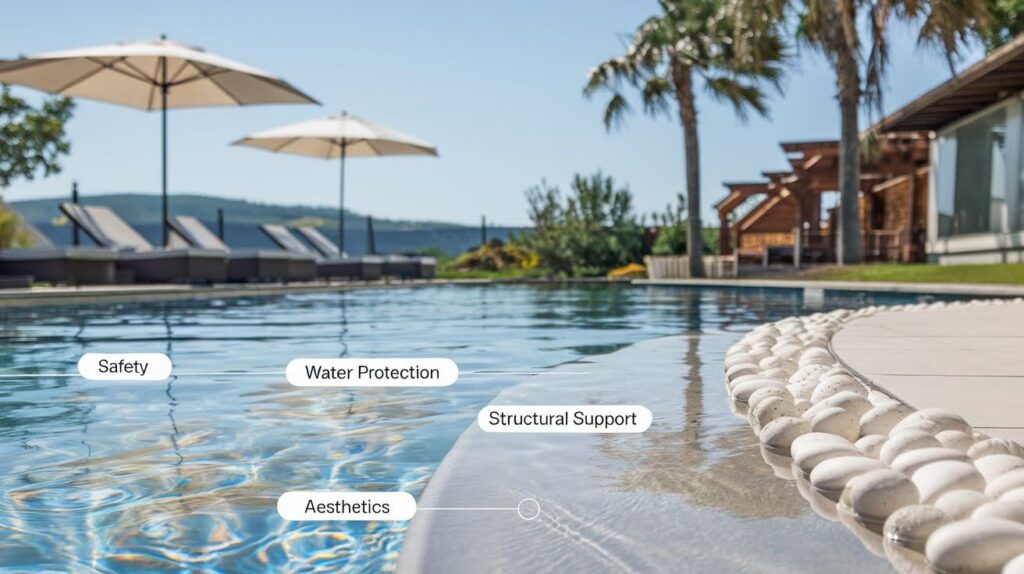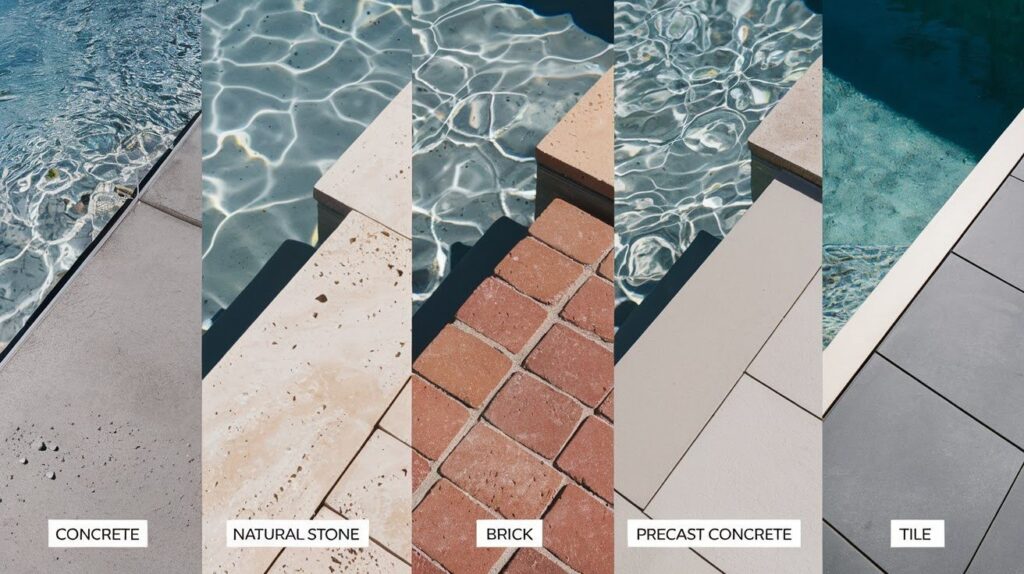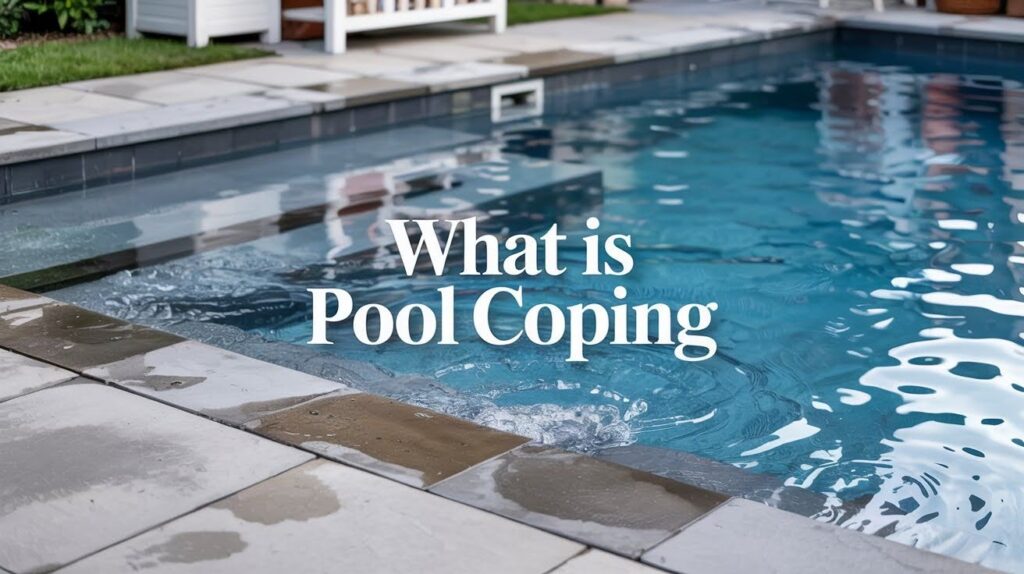What is pool coping exactly? You’re looking at that finished edge around swimming pools and wondering what it’s called. Maybe you need to replace yours or you’re building a new pool. I get it. Pool terminology can be confusing.
Pool coping is the cap or border material on top of your pool wall. It connects your pool to the deck area. Think of it as your pool’s protective border. This guide covers everything about pool coping. You’ll learn about different materials, costs, and installation steps. I’ll explain maintenance tips and current design trends too.
I’ve helped hundreds of homeowners choose the right coping. My experience will save you from expensive mistakes. You’ll understand which options work best for your pool type and budget.
You’ll know exactly what pool coping is and how to pick the perfect choice.
Why Pool Coping Matters: Functionality & Benefits

Pool coping isn’t just about looks. It serves several important purposes that protect both your pool and your wallet.
Water Protection Coping creates a seal that keeps water from getting behind your pool walls. Water damage can cost thousands to repair. The right coping prevents this expensive headache. Safety First Smooth, rounded coping edges prevent cuts and scrapes. Sharp pool walls can seriously injure swimmers getting in and out of the water.
You want your pool area to be safe for everyone.
Structural Support Coping helps hold your pool walls in place. It distributes weight evenly and prevents cracking. This extends your pool’s lifespan. Easy Maintenance Quality coping makes cleaning simpler. Dirt and debris won’t collect in gaps and crevices. Your pool stays cleaner with less effort.
Property Value Nice looking coping increases your home’s value. Potential buyers notice well-maintained pool areas immediately.
Different Types of Pool Coping

Several materials work well for pool coping. Each has its own benefits and drawbacks.
Concrete Coping The most popular choice for good reason. Concrete is:
- Affordable and widely available
- Customizable with colors and textures
- Durable when properly installed
- Easy to repair if damaged
Downside: Can crack over time in freeze-thaw climates.
Natural Stone Coping Premium materials like travertine, limestone, and sandstone offer:
- Timeless, attractive appearance
- Cool surface temperature in hot weather
- Natural patterns and colors
- Excellent durability
Downside: Higher upfront costs and requires sealing.
Brick Coping Classic red brick creates a traditional look. Benefits include:
- Weather-resistant properties
- Slip-resistant surface texture
- Complements many architectural styles
- Moderate pricing
Downside: Limited color options compared to other materials.
Precast Concrete Coping Manufactured concrete pieces provide:
- Consistent appearance and sizing
- Quick installation process
- Various design options available
- Cost-effective solution
Downside: Less customization than poured concrete.
Tile Coping Ceramic or porcelain tiles offer:
- Wide variety of colors and patterns
- Smooth, easy-to-clean surface
- Water-resistant properties
- Modern, sleek appearance
Downside: Can be slippery when wet and more expensive.
Pool Coping Styles by Pool Type

Different pool types work better with specific coping styles.
Inground Pools Most inground pools use bullnose coping. This rounded edge style:
- Provides comfort for swimmers
- Looks professional and finished
- Works with any pool shape
- Prevents water from pooling on the edge
Above Ground Pools Above ground pools typically use flat coping or cap coping:
- Flat coping sits flush with the pool wall
- Cap coping extends slightly over the edge
- Both styles are budget-friendly
- Installation is straightforward
Infinity Pools These dramatic pools require specialized cantilever coping:
- Extends beyond the pool wall
- Creates the “disappearing edge” effect
- Requires expert installation
- Commands premium pricing
Spa and Hot Tub Coping Smaller water features often use step-down coping:
- Creates multiple levels for visual interest
- Provides seating areas
- Accommodates different depths
- Adds to the relaxation experience
How Pool Coping Is Installed: Step-by-Step
Professional installation ensures your coping lasts for decades. Here’s how the process works:
Step 1: Preparation The installer measures your pool perimeter carefully. They order materials with 10% extra for cuts and potential damage.
Step 2: Setting the Base A mortar bed goes on top of the pool wall. This creates a level surface for the coping material.
Important: The base must be perfectly level. Uneven coping looks unprofessional and can cause water problems.
Step 3: Placing the Coping Each piece gets set into the mortar bed. The installer checks alignment constantly. Gaps between pieces should be consistent.
Step 4: Grouting and Sealing Joints get filled with weather-resistant grout. Some materials need sealing for protection against water and stains.
Step 5: Final Inspection The installer checks every joint and edge. Any imperfections get corrected before the job is complete.
Most installations take 2-3 days for average-sized pools. Weather conditions can affect timing.
Cost of Pool Coping
Pool coping costs vary widely based on material choice and pool size.
|
Material Type |
Cost Per Linear Foot |
Examples |
|
Budget Options |
$8-15 |
Basic concrete, precast pieces, standard brick |
|
Mid-Range Choices |
$15-30 |
Textured concrete, sandstone, ceramic tiles |
|
Premium Materials |
$30-60+ |
Travertine, limestone, custom concrete, porcelain |
Installation Costs: Labor adds $10-20 per linear foot. Complex designs cost more.
Total Project Cost: A typical 20×40 foot pool needs 120 linear feet of coping. Total costs range from $2,000 to $10,000+ depending on materials.
Money-Saving Tip: Get quotes from multiple contractors. Prices can vary significantly between companies.
Maintenance & Repair Tips
Proper maintenance keeps your pool coping looking great for years.
- Sweep debris weekly and pressure wash monthly during pool season
- Reseal natural stone coping every 2-3 years to prevent water damage
- Fix small cracks immediately with concrete filler or color-matched mortar
- Avoid harsh chemicals that can damage coping materials
- Call professionals for large cracks, loose pieces, or water pooling issues
Catching problems early saves money and prevents bigger issues.
Pool Coping Design Trends
Current design trends focus on natural materials and clean lines.
Popular Color Choices Homeowners prefer warm gray tones, cream and beige neutrals, cool blue-gray options, and natural stone colors.
Texture Preferences People want surfaces that are slip-resistant for safety, comfortable for bare feet, easy to clean and maintain, and visually interesting without being busy.
Integration with Decking Modern designs blend coping with deck materials. This creates a seamless transition that looks intentional and professional.
Sustainable Options Eco-friendly materials are gaining popularity. These include recycled concrete products, locally-sourced natural stone, permeable materials that manage water runoff, and long-lasting options that reduce replacement needs.
Minimalist Approaches Simple, clean designs are replacing ornate styles. Straight lines and geometric shapes create contemporary looks that won’t go out of style.
Conclusion
Pool coping is more than just a finishing touch for your pool. It protects your investment and keeps your family safe. The right coping material prevents water damage that costs thousands to repair. You now understand the different types available. Concrete offers affordability while natural stone provides lasting beauty. Each material has its place depending on your budget and style preferences.
Installation matters as much as material choice. Professional contractors ensure proper sealing and alignment. This prevents future problems and maintains your warranty coverage. Regular maintenance extends your coping’s lifespan significantly. Simple cleaning and occasional resealing keep everything looking fresh. Small repairs done early prevent expensive replacements later.
Choose materials that match your pool type and local climate. Get multiple contractor quotes before making decisions. Your pool coping investment will serve you well for decades when done right.
Frequently Asked Questions
Can I install pool coping myself?
Pool coping installation requires precise measurements and proper mortar work. Most homeowners should hire professionals to avoid costly mistakes and ensure proper water sealing.
How long does pool coping last?
Quality pool coping can last 15-25 years with proper maintenance. Natural stone and concrete options typically outlast tile materials in harsh weather conditions.
What happens if I don’t replace damaged coping?
Damaged coping allows water to seep behind pool walls, causing structural damage. This can lead to expensive repairs costing thousands more than simple coping replacement.
Does pool coping affect my pool’s warranty?
Improper coping installation can void your pool’s structural warranty. Always use licensed contractors and approved materials to maintain warranty coverage.
Can I change my pool coping style later?
Yes, you can replace existing coping with different materials or styles. However, removal costs add to the project expense, making initial selection important

